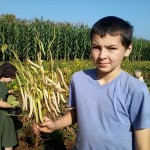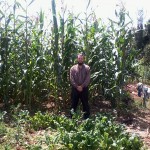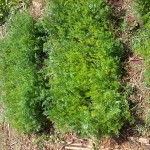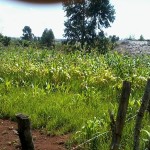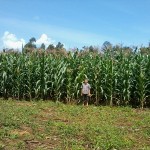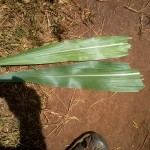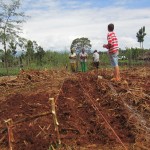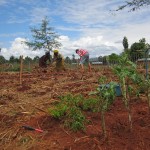I (Marc) was invited to a one-day sustainable farming seminar by Heaven’s Family in the Fall of 2012. Being a degreed scientist, a homesteader (even back in the US), a teacher and missionary, I latched onto the concept immediately. Now our family had adjusted to growing much of our own food even when living in the US. We already knew how to farm and preserve foods. However, adjusting to a maize and beans economy and dry storing rather than canning was a big adjustment. Also, we were used to going to the local farm supply store in the US and getting whatever we needed. Here, there is no such thing as a general all-purpose fertilizer (12-12-12). We just have nitrogen-rich DAP and CAN locally, which are not ideal for beans and vegetables. They use a foliar spray (like MiracleGro®) for crops other than maize. The other big change was the seasons. Here it is long rains, short rains, and dry. In the mid-west we simply had the actual four seasons. Not here.
The seminar was taught by Craig Sorley who leads an initiative to empower Africa with practical and sustainable agriculture. His teachings were nearly entirely based on “Farming God’s Way” FGW (see www.farming-gods-way.com). He taught a lot of biblical concepts concerning sustainable agriculture but I will emphasize the science here. The thesis is that God made things to work a certain way in the wild and if we leverage His methods in our cultivation of crops we can greatly increase yield and restore our land. I will give you my best description in as few words as possible. In the wild, trees are interspersed with other plants and provide a blanket of cover or mulch on the earth. Trees pull nutrient from depth and reintroduce that nutrient to the topsoil. The organic matter protects the earth from erosion, provides a habitat for worms, bacteria, and other beneficial organisms that create a very healthy, rich soil structure. The ground cover prevents evaporation and runoff and ensures that all the precipitation is absorbed and remains available for the plant roots. Other benefits of ground cover include inhibiting weed germination and propagation.
The other concept introduced was precision. Precise inputs and methods will lead to predictable outputs. Measuring plant spacing, seed and fertilizer depth and amounts precisely will lead to maximized yields. We are talking about engineering the field. Optimal spacing means inhibiting sunlight availability for weeds and maximum outputs per farming area. Crop rotation for pest reduction and to prevent nutrient depletion is also recommended (beans also fix nitrogen for future maize crops).
Our garden is huge by US standards but a standard small shamba (farm) by African standards. It is the perfect size to test this methodology. Our field is approximately 100 feet by 40 feet. I divided the shamba into five 40 feet by 20 feet parcels for crop rotation purposed. We started by adding mulch in the form of maize stalks and river grass and resting the field for the Fall of 2012. We consistently weeded and/or sprayed with a RoundUp® equivalent during the dry season to minimize weeds in the future. We were amazed that what little rain the dry season gave us kept the soil moist even during the dry season where the mulch depth was sufficient. Now only one of our five sections had full coverage of a few inches of mulch. The other sections had variable coverage. We learned that grasses are much better than corn stalks for mulching. We only had enough grass for one section. Any seedless, non-poison leafy material will work for cover but the smaller the materials the better it holds back weeds and holds in moisture. We also have trees interspersed in our shamba, primarily a fast-growing variety that does not make much shade.
For the first crop we planted two sections of beans and two of maize. One of the bean sections also contained four rows of open-polinated maize seeds just to create seed for next year. The remaining section was for vegetables. We used just a mixed bean bag we eat from for bean seeds and Kenya Seed Company 6213 hybrid for the maize plots. We selected this variety because that is what everyone else around us is using and we want to compare apples with apples.
Now we planted a month after the rains because I suffered a serious leg injury in a motorbike accident. Therefore, when I compare my neighbor’s maize to mine they still had a month head start. Now I followed the FGW guidance to the best of my ability. In the end it was African volunteers and my family doing the labor and there are limits to how perfect they can follow instructions. Maize was spaced at 60 cm plant to plant with three seeds per hole with rows 75 cm apart. Now in actuality the holes were not 60 cm on center but rather 60 cm edge to edge meaning the spacing was a little wider than specified. As a result, I did not thin to two plants per hole but left all strong plants. The holes were dug about 8 to 10 cm deep and a mixture of lime/DAP was added per FGW specification. A little soil was returned and the seeds were planted at 5 cm depth. At a foot height, maize was top-dressed with CAN as specified.
For beans, furrows were dug about 8 to 10 cm deep and a lime/fertilizer mixture was applied and the furrow was backfilled and seeds were supposed to be planted at 3 cm depth. However, I lost control of the team at the bean plot. The rows were supposed to be 37.5 cm on center and seeds planted at 10 cm spacing. However, they DID NOT use strings to mark lines and just winged it by the fifth row. I can’t complain as they were all volunteers. Germination was not very good. Next time I will just plant many and thin the weaker plants. I will also do it myself for the sake of precision. They also rushed through the job and worked it with tools rather than by hand. In some places they placed the seeds in a different place than the fertilizer furrows and even placed the mulch over the plants. It was a bit messy. The moral of the story is that it is a difficult thing to get Africans to slow down for the sake of precision in lieu of just getting the job done as quickly as possible. Beans were later sprayed with a foliar spray a few times.
Weeding was done every couple weeks by the children or others while the weeds were small BEFORE they flower. Where the cover was thick and consisted of grasses, weeds were sparse. Wherever cover was light, we had more weeds. However, the weed density was far less than the community fields around us with zero mulch cover.
The vegetable plot is a mix of spinach, carrots, onions, collards, and garlic. It is where my children have their little beds of crops. Therefore, it is not FGW, but rather “farming Micah’s way, farming Isaiah’s way, and farming Jonah’s way.” That plot has the thinnest mulch cover as well. But the crops look pretty good.
Now there are three genres of crops around us: the average African field where inputs were deficient and crops are intermixed, a good commercial African field, and FGW. The fields with deficient inputs are pathetic. The maize is yellow and yield will not be worth the cost and effort. They typically mix their maize and beans (or millet) and get just a few bean pods per bean plant and small or even underdeveloped maize, if any at all.
The commercial fields have the inputs necessary, and do pretty good if the rains are there. However, it is a lot more work weeding and extra cost tilling the land. They also suffer from erosion loss, evaporation, and a dense impenetrable cake layer on the surface. No worms or beneficial critters amending the soil either. They do not apply lime. Also, much of the fertilizer applied gets washed away with rain or spreads to feed the weeds rather than the maize. The little hole in the mulch when FGW ensures that ALL inputs go to the maize.
Our neighbor Henry is a great African commercial farmer. He does everything “right” and gets a good yield. He planted a month before we did and his maize stayed ahead of ours for a while. However, when rains were intermittent our maize outperformed his. With the same volume of inputs and same variety of seed, even though he planted a month before us, our FGW maize is two feet taller than his and is a deep green rather than a yellow green. And his beans yielded about 12-15 pods per plant whereas ours yielded 25-30 pods per plant. And that is with a healthy rainy season. If drought came, the difference would have been even more remarkable.
As a result of our exceptional crop performance we are the talk of the town. This was our intention. This demonstration plot will lead into teaching multiple short seminars on the benefit of both project management and planning principles and FGW techniques. Pray with us that the Lord will use these principles to thrust these folks from poverty.

